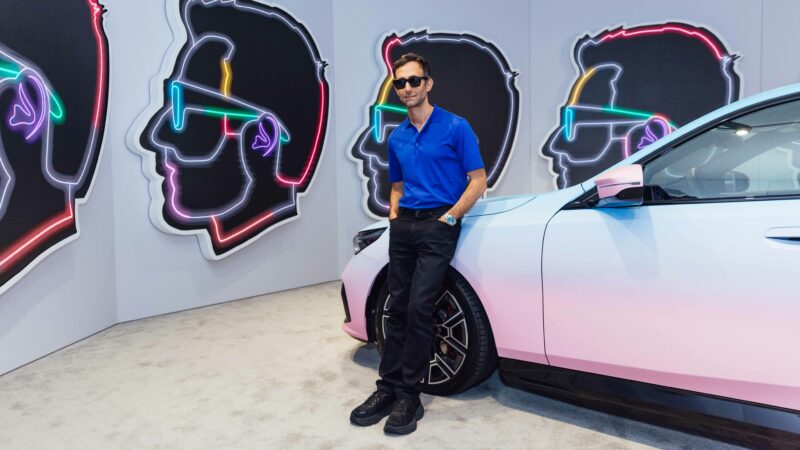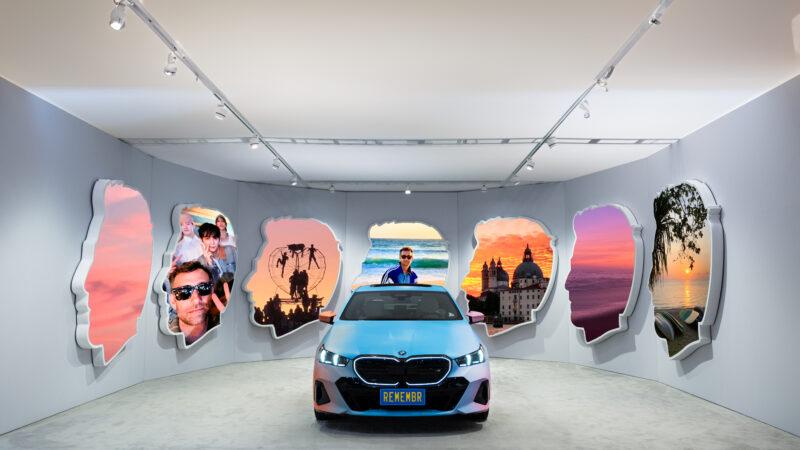PRG dives into the artist’s AI collaboration with BMW, titled REMEMBR.

PRG sat down with renowned artist Alex Israel to discuss his December 2023 exhibit REMEMBR: a fusion of custom LED and crowd sourced content. Presented at Art Basel in collaboration with BMW and featuring technical expertise from PRG, this immersive experience blends contemporary art and cutting-edge technology for a unique experience that allows the viewer to become a part of the artwork.
Users engaged with the REMEMBR exhibit by submitting their memories through a dedicated platform. The process involved uploading personal images and experiences, transforming them into dynamic content displayed on the seven LED screens. This interactive approach allowed attendees to contribute to the immersive narrative, creating a collective tapestry of memories displayed as art for all to see.
The interview focuses on the role of the custom LED screens, mirroring Israel’s ubiquitous Self-Portrait, and explore the fabrication process, challenges, and the seamless fusion of artistic vision with the innovative prowess of BMW. Discover how this groundbreaking collaboration took the audience on a multi-sensory voyage through memories, pushing the boundaries of AI’s role in immersive installations.
PRG: Can you describe the role of technology in the REMEMBR exhibit, and specifically, how did video screens contribute to the immersive experience?
Alex Israel: The entire project is fueled by technology, from the AI we developed to program the videos, to the LED screens themselves. Making the screens in the shape of my Self-Portrait makes them unique in the world. We all look at rectangular screens all day long and I really wanted to make something different. The fact that the REMEMBR videos can only play across them, and that they are only to be found at the locations of our activations, this specificity makes the experience of this artwork rare, alive, shared and urgent, and hopefully heightens our users’ emotion around it.
How did the collaboration with PRG come about, and how did you go about choosing the right LED screens for this installation?
I was introduced by a close friend of mine who has worked extensively in the live events industry, Willo Perron. I mentioned wanting to make customized screens and he connected me with PRG. I visited the office, learned about the various LED resolutions and costs, and we went from there.
These video screens were custom cutouts to align with your artistic vision for the REMEMBR exhibit, how was the experience working with PRG to get your art just right?
PRG helped me realize the vision with limited time and resources. It was a project I’d been hoping to realize for some time, and I began conversations with PRG a few years ago. When the call came in from BMW that they wanted to realize the vision together, PRG jumped in to help me and we brought the idea to life with just under three months until showtime. There were elements of the vision that were hard to pull off, and there was troubleshooting that had to happen along the way, but PRG helped engineer a result that ultimately performed exactly as I’d hoped.
The immersive experience aims to take viewers on a journey through their memories. Can you discuss the importance of the screen as a canvas, taking on a dynamic adaptive quality in creating a multi-sensory experience for the audience?
Turning my Self-Portraits into screens was a full circle moment for me. The Self-Portrait image was born on-screen, as a logo for my web series “As It Lays.” It evolved from there into a series of paintings, products and augmented reality experiences activated through a smartphone. It was always positioned, in its various iterations, in relationship to the screens that permeate our culture. With REMEMBR, it’s as if my Self-Portrait finally fulfilled its fate of becoming one itself.
What was the most important factor in combining your own artistic vision with the overarching concept of the BMW collaboration, ensuring a harmonious and cohesive experience for the visitors?
The reason the project worked so well is that the partnership with BMW was very organic. For example, the technology going into their new cars uses AI to create a more dynamic relationship between car and driver, and the head designer at the company, Domagoj Dukec, understands the profound effects of colored interior lights (BMW’s “My Modes”) and sound on each driver’s experience. I was considering similar concerns as I realized REMEMBR: how could I highlight the ever-narrowing gap in synergy between man and machine? How might I stir emotion through colorful animation and pop music? Our visions are quite parallel and that allowed for an extremely productive collaboration.

In what ways do you see the use of cutting-edge technology, such as AI, pushing the boundaries of artistic expression in the realm of immersive installations?
AI is an incredible tool for artists. It can already do things never before possible at speeds that were once unthinkable. Immersive installations are often enhanced by real-time, live components that give them urgency and immediacy. AI can think quickly and support this kind of live-performative-feedback-loop.
What do you hope the combination of art and tech will leave in the minds of those who experienced REMEMBR at Art Basel?
I hope they REMEMBR it, that they enjoyed seeing their lives on the big screens, and that they were able to use the artwork as it was intended: to give them a moving look back at some life moments they might have forgotten, while making themselves vulnerable as those moments are shared with friends and strangers alike.
Further information from PRG: www.prg.com


